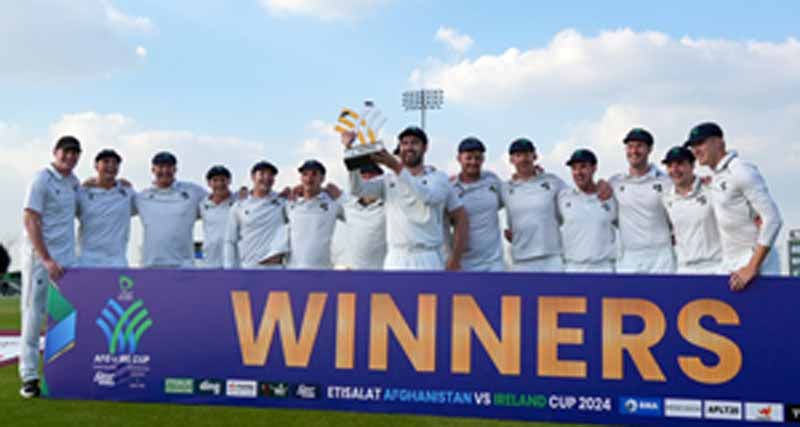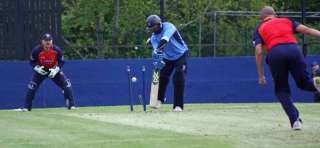The article below first appeared here https://theparttimer.substack.com/p/explained-where-are-this-years-player and is reproduced by the kind permission of the author. You can follow Nathan Johns on Twitter handle - @nathanrjohns
Amid all the recent chatter around at-risk Test matches, missing world champions and expensive company cars, one vital piece of the Irish cricketing jigsaw has been conspicuous by its absence. Where is the list of centrally contracted players for 2024?
On March 2nd, 2023, Cricket Ireland announced 27 central contracts for male players ahead of the forthcoming season. Four days later, 23 deals for Irish women were revealed.

As of this week, mid-April 2024, more than 12 months on, there has been no update on this year’s list of professional Irish cricketers. The reason the public is in the dark is because players themselves are too. The financial uncertainty which forced the redrawing of budgets and delays to the announcing of fixtures has spilled over into contract negotiations. While it sounds like belated news of international matches is on the way, talks between players and the governing body have not yet reached a fruitful outcome.
As the women start their summer with the imminent T20 World Cup qualifiers and the men are less than a month from the beginning of their home campaign, no one has yet put pen to paper for this year. It’s not just players. Backroom staff have been affected as well.
Cricket Ireland’s player contract system runs on a calendar year of March-February. The most recent central contracts expired on February 29th. In some cultures, leap years are considered good luck. Ireland’s cricketers would disagree, given they have had to play a number of matches after the expiration of their previous contracts.
The main reason games after March 1st went ahead is because an agreement was reached between Cricket Ireland and the Irish Cricketers’ Association (ICA), the union representing the players. Whatever terms an individual player was on prior to February 29th will carry over indefinitely until new, up-to-date contracts are agreed. Those who earned Ireland’s historic first Test victory did so on out-of-date contracts.
This was a short-term solution, far from ideal for everyone involved, but it ensured that players still took to the field with an element of financial security. They were also still protected by various injury policies.
Irish contracts are collectively bargained on behalf of players by the Irish Cricketers’ Association (ICA). Certain individuals have wanted to negotiate higher rates for themselves in the past but, by and large, players acknowledge that the cricket playing collective as a whole fares better financially if everyone is represented by the union.
Once pay and benefits are thrashed out with CI, players are assigned to a salary band. Individual player agents tend not to be involved. The ICA’s website lists Cecelia Joyce, a former international and a current lawyer with A&L Goodbody, and George Dockrell as the president and vice-president respectively. They lead the negotiations.
In terms of salary, there are six types of contracts available to Irish players. Five of these are bands or groups, increasing from lowest to highest in annual value. On the men’s side, there can be as much as a €10,000 difference between individual bands. CI and the ICA agree on the figures associated with each category and players are placed into a band by coaches and high performance staff. Each season, players can be moved up or down the bands, their salaries increasing or decreasing, depending on performance.
Precise figures for bands are not available, but the lowest for the men has previously been in the region of €25,000. There is also a captaincy stipend which tops up that individual’s salary.
Within those bands, a player can be on a full-time or an educational contract. Most of the education deals are on the women’s side, given the young age profile of that squad. A player can be in any contract grouping while also on an educational deal. In theory, a valuable student can still be in band A despite not being a full-time professional. They are paid on a pro rata basis within their bracket for the time they are available away from their studies.
It can get even more complicated. Last year, CI explained that Gaby Lewis, a university student, was on an educational contact during term time, only to shift to a full-time contract - and therefore a pay rise - during holidays. Once term started again, she would go back to being part-time. When school and university years finish in May/June, various players are presented with the option of going full-time midway through their contractual year, meaning a potential pay rise is on the cards. It is an administrative nightmare.
Outside of those five bands there are also casual contracts. These deals do not provide a salary, only match fees and per diems while in camp but they do get individuals on the books where they can access injury treatment and strength and conditioning support; all the trimmings of professional sport minus the cash.
On the men’s side, there are multi-year contracts. These are not in place for the women but are expected to be introduced from this year. Barring one notable exception, male multi-year contracts only came back into play in 2022. They had previously been in use from 2014-15 in the build-up to Ireland’s last ODI World Cup appearance. Unsurprisingly, the ICA had been lobbying for the reintroduction of longer contracts which give players more security.
The one Irish player who, prior to 2022, was on a deal which lasted longer than 12 months was Paul Stirling. He was given a three-year contract when he had a decision to make between staying with Ireland, a new ICC full member, or sacrificing his international career to remain at Middlesex.
When discussions started between CI and the ICA in October, it became clear that players wanted a pay rise. After all, a tranche of new ICC money was on the way. CI, though, did not find out exactly how much cash would be forthcoming from Dubai until March, after the expiration of the most recent deals.
It has been well documented at this stage that CI’s bid to convince the ICC to release an additional $1.5 million in funding, which they will receive anyway at some point between now and 2027, came up short. Then the cost of hosting South Africa in the UAE increased significantly. Budgets had to be redrawn, meaning the announcement of fixtures was delayed to figure out what could be afforded. Player contracts and any potential salary increases befell the same fate. If there was a plan B budget to cater for all of this, it has taken a while to implement given that disappointing ICC meeting took place on March 14th.
Alongside pay rises, gender parity - or something resembling it - is also a significant goal on both sides of the negotiating table. Equal pay for men and women is not going to happen this year. CI can’t afford to bump up women’s salaries to that extent while the men won’t see their pay more than halved in some instances, depending on the contract band.
A quick fix, which we have seen in other sports, particularly soccer, is to simply equate the match fees. In reality, though, that would just be a headline. Match fees are dependent on selection and the governing body not cutting back on fixtures. They are volatile. Salaries are what ultimately pay the mortgage. Most of Ireland’s female players live in Dublin in all its expensive glory.
If funds are tight, it makes more sense to acknowledge a salary pay gap but shrink it as much as possible, rather than slap on the equal match fees headline and move on. As a result, women’s salary bands are expected to increase substantially more than those of the men, proportionally speaking.
Just over a month after that disappointing ICC meeting, it sounds like CI has figured out what money it has at its disposal. Interpro fixtures have been confirmed, while a decision on domestic red ball and international fixtures could be announced after Thursday’s board meeting.
Player contracts, though, have not yet been agreed. Previously contracted players know if they have a deal or not for 2024, and if they are on a single or multi-year arrangement. Potential new contractees still have to wait and see.
Players also have a fair idea of what band level they will fall into, but negotiations on the value of these salaries remain ongoing. Thursday’s board meeting, which will in theory sign off on CI’s now redrawn budget, should accelerate those conversations.
The ICA has been given access to CI’s budget to know what exactly it is dealing with. Other cricket boards attach player salaries to a percentage of overall revenue, depending on an agreed amount which is generated directly by players, something which is being sought on behalf of Irish cricketers.
Valuable employees looking to be paid more money and come to industry standard arrangements don’t seem to be unreasonable demands. Yet akin to those wondering if CI was in a financial position to partake in industry standard company car procedures for senior staff, it’s fair to wonder if the board is now in a position to engage in other standard practices around salary increases and revenue sharing, given recent financial uncertainty.
Granted, that line of thought is severely weakened by the cost and brand of cars recently bought by the organisation. The purchase of two new company Teslas, each worth €56,000, a figure higher than roughly 75% of player salaries, can only have undermined CI’s negotiating position.
Contract discussions are delicate, private affairs. We likely will never get a full picture of these negotiations. Yet there has been a hold-up, players have had to play on out-of-date deals. If this were another, more mainstream sport, it would be covered, perhaps not as a scandal, but a significant governance embarrassment. Especially given the Teslas.
Come Wednesday, negotiations may well pick up a head of steam. Thursday’s board meeting will likely confirm a reality that has become readily apparent when reading between the lines of this ongoing process. CI is still in a position to offer pay rises first discussed in October, but, after recent financial events, not to the extent everyone had previously hoped.
Should contracts be agreed in the next fortnight, any increases will be backfilled from March 1st, when the deals were supposed to have kicked in. If players come down a salary band from last year, there is a theoretical possibility of being paid too much and having to return some of their salary. Reassurances have been offered that increases in lower bands should avoid that reality.
Players are sympathetic to the unexpected worsening of CI’s financial situation, but nonetheless frustrated at the delay. CI simply wants to look after its most valuable employees as much as is financially possible. The next fortnight is a vital period to ensure the stakeholders who are often forgotten in the wider discussion on Irish cricket’s bleak financial picture don’t continue to play under a cloud of uncertainty.




